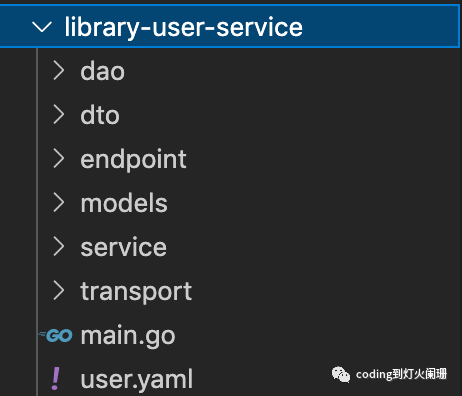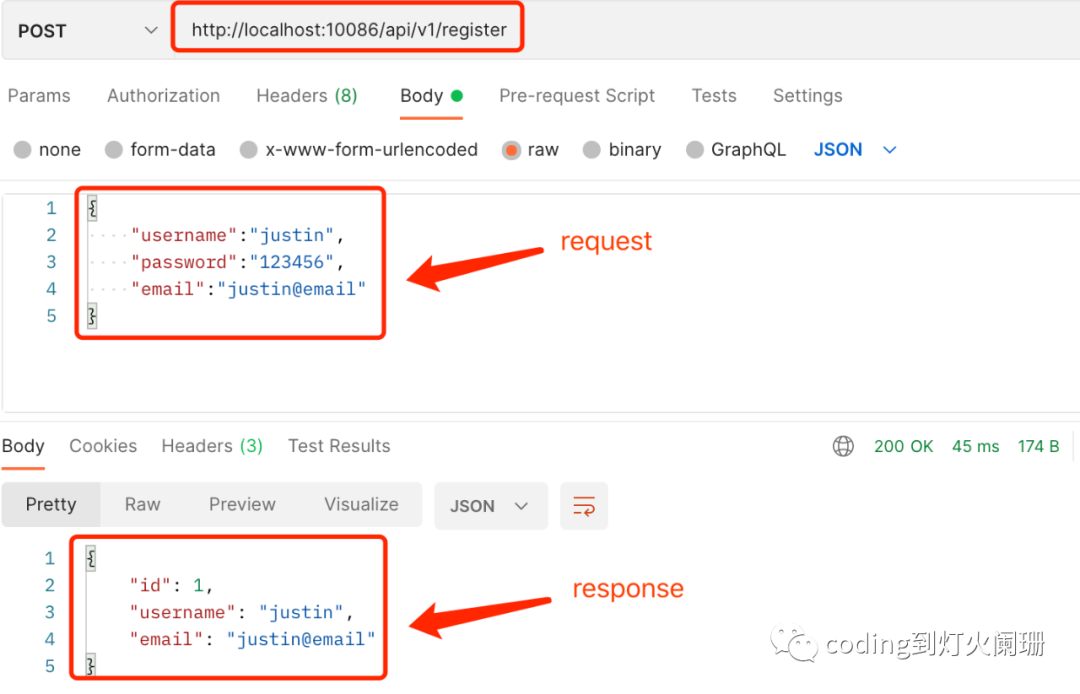Microservice library user service, user management service. It provides a Restful interface for user management, which mainly realizes the functions of user registration, querying users according to user ID or email, querying books borrowed by users, etc.
Full code:
https://github.com/Justin02180218/micro-kit
Package structure description

-
dao: data access layer
-
dto: data transmission layer
-
models: database table mapping layer
-
service: business logic layer
-
Endpoint: the concept of go kit encapsulates every method provided by the service into an endpoint.
-
Transport: go kit concept, protocol transport layer, support grpc, thrift, http and other protocols are used in combination with gin web framework.
-
user.yaml: configuration file used by the service
-
main.go: Service initiator
code implementation
Database table
First, create the user table in the library database
CREATE TABLE `user` ( `id` bigint(20) NOT NULL AUTO_INCREMENT, `username` varchar(255) DEFAULT '', `password` varchar(255) DEFAULT '', `email` varchar(255) DEFAULT '', `created_at` datetime DEFAULT NULL, `updated_at` datetime DEFAULT NULL, PRIMARY KEY (`id`) ) ENGINE=InnoDB DEFAULT CHARSET=utf8;
models layer
Create user.go in the models layer and define the User struct corresponding to the table user:
type User struct {
ID uint64 `gorm:"primary_key" json:"id" form:"id"`
CreatedAt time.Time `form:"created_at" json:"created_at"`
UpdatedAt time.Time `form:"updated_at" json:"updated_at"`
Username string
Password string
Email string
}dao layer
Create a user that interacts with the database in the Dao layer_ dao.go
Define UserDao interface and its implementation:
type UserDao interface {
SelectByID(id uint64) (*models.User, error)
SelectByEmail(email string) (*models.User, error)
Save(user *models.User) error
}
type UserDaoImpl struct{}
func NewUserDaoImpl() UserDao {
return &UserDaoImpl{}
}-
SelectByID: query user information according to user ID
-
SelectByEail: query user information according to user email
-
Save: save user information
Function implementation of UserDao interface:
func (u *UserDaoImpl) SelectByID(id uint64) (*models.User, error) {
user := &models.User{}
err := databases.DB.Where("id = ?", id).First(user).Error
if err != nil {
return nil, err
}
return user, nil
}
func (u *UserDaoImpl) SelectByEmail(email string) (*models.User, error) {
user := &models.User{}
err := databases.DB.Where("email = ?", email).First(user).Error
if err != nil {
return nil, err
}
return user, nil
}
func (u *UserDaoImpl) Save(user *models.User) error {
return databases.DB.Create(user).Error
}dto layer
User in dto layer_ Create struct UserInfo and RegisterUser for data transmission in dto.go:
type UserInfo struct {
ID uint64 `json:"id"`
Username string `json:"username"`
Email string `json:"email"`
}
type RegisterUser struct {
Username string
Password string
Email string
}service layer
Create user in the service layer_ service.go
Define UserService interface and Implementation:
type UserService interface {
Register(ctx context.Context, vo *dto.RegisterUser) (*dto.UserInfo, error)
FindByID(ctx context.Context, id uint64) (*dto.UserInfo, error)
FindByEmail(ctx context.Context, email string) (*dto.UserInfo, error)
}
type UserServiceImpl struct {
userDao dao.UserDao
}
func NewUserServiceImpl(userDao dao.UserDao) UserService {
return &UserServiceImpl{
userDao: userDao,
}
}Function implementation of UserService interface:
func (u *UserServiceImpl) Register(ctx context.Context, vo *dto.RegisterUser) (*dto.UserInfo, error) {
user, err := u.userDao.SelectByEmail(vo.Email)
if user != nil {
log.Println("User is already exist!")
return &dto.UserInfo{}, ErrUserExisted
}
if err == gorm.ErrRecordNotFound || err == nil {
newUser := &models.User{
Username: vo.Username,
Password: vo.Password,
Email: vo.Email,
}
err = u.userDao.Save(newUser)
if err != nil {
return nil, ErrRegistering
}
return &dto.UserInfo{
ID: newUser.ID,
Username: newUser.Username,
Email: newUser.Email,
}, nil
}
return nil, err
}
func (u *UserServiceImpl) FindByID(ctx context.Context, id uint64) (*dto.UserInfo, error) {
user, err := u.userDao.SelectByID(id)
if err != nil {
return nil, ErrNotFound
}
return &dto.UserInfo{
ID: user.ID,
Username: user.Username,
Email: user.Email,
}, nil
}
func (u *UserServiceImpl) FindByEmail(ctx context.Context, email string) (*dto.UserInfo, error) {
user, err := u.userDao.SelectByEmail(email)
if err != nil {
return nil, ErrNotFound
}
return &dto.UserInfo{
ID: user.ID,
Username: user.Username,
Email: user.Email,
}, nil
}
endpoint layer
Create user in the endpoint layer_ endpoint.go,
Define UserEndpoints struct, and each request corresponds to an endpoint.
type UserEndpoints struct {
RegisterEndpoint endpoint.Endpoint
FindByIDEndpoint endpoint.Endpoint
FindByEmailEndpoint endpoint.Endpoint
}
Create each endpoint
func MakeRegisterEndpoint(svc service.UserService) endpoint.Endpoint {
return func(ctx context.Context, request interface{}) (response interface{}, err error) {
req := request.(*dto.RegisterUser)
user, err := svc.Register(ctx, req)
if err != nil {
return nil, err
}
return user, nil
}
}
func MakeFindByIDEndpoint(svc service.UserService) endpoint.Endpoint {
return func(ctx context.Context, request interface{}) (response interface{}, err error) {
id, _ := strconv.ParseUint(request.(string), 10, 64)
user, err := svc.FindByID(ctx, id)
if err != nil {
return nil, err
}
return user, nil
}
}
func MakeFindByEmailEndpoint(svc service.UserService) endpoint.Endpoint {
return func(ctx context.Context, request interface{}) (response interface{}, err error) {
email := request.(string)
user, err := svc.FindByEmail(ctx, email)
if err != nil {
return nil, err
}
return user, nil
}
}transport layer
Request forwarding adopts the combination of gin web framework and go kit transport. Therefore, http_ Define a Router in util.go and return to gin.Engine
func NewRouter(mode string) *gin.Engine {
gin.SetMode(mode)
r := gin.New()
r.Use(gin.Recovery())
return r
}In user_ The NewHttpHandler defined in transport.go returns gin.Engine, and the request handler of gin is processed by http.NewServer of go kit.
func NewHttpHandler(ctx context.Context, endpoints *endpoint.UserEndpoints) *gin.Engine {
r := utils.NewRouter(ctx.Value("ginMod").(string))
e := r.Group("/api/v1")
{
e.POST("register", func(c *gin.Context) {
kithttp.NewServer(
endpoints.RegisterEndpoint,
decodeRegisterRequest,
utils.EncodeJsonResponse,
).ServeHTTP(c.Writer, c.Request)
})
e.GET("findByID", func(c *gin.Context) {
kithttp.NewServer(
endpoints.FindByIDEndpoint,
decodeFindByIDRequest,
utils.EncodeJsonResponse,
).ServeHTTP(c.Writer, c.Request)
})
e.GET("findByEmail", func(c *gin.Context) {
kithttp.NewServer(
endpoints.FindByEmailEndpoint,
decodeFindByEmailRequest,
utils.EncodeJsonResponse,
).ServeHTTP(c.Writer, c.Request)
})
}
return r
}
Start service
Complete main.go
var confFile = flag.String("f", "user.yaml", "user config file")
func main() {
flag.Parse()
err := configs.Init(*confFile)
if err != nil {
panic(err)
}
err = databases.InitMySql(configs.Conf.MySQLConfig)
if err != nil {
fmt.Println("load mysql failed")
}
ctx := context.Background()
userDao := dao.NewUserDaoImpl()
userService := service.NewUserServiceImpl(userDao)
userEndpoints := &endpoint.UserEndpoints{
RegisterEndpoint: endpoint.MakeRegisterEndpoint(userService),
FindByIDEndpoint: endpoint.MakeFindByIDEndpoint(userService),
FindByEmailEndpoint: endpoint.MakeFindByEmailEndpoint(userService),
}
ctx = context.WithValue(ctx, "ginMod", configs.Conf.ServerConfig.Mode)
r := transport.NewHttpHandler(ctx, userEndpoints)
errChan := make(chan error)
go func() {
errChan <- r.Run(fmt.Sprintf(":%s", strconv.Itoa(configs.Conf.ServerConfig.Port)))
}()
go func() {
c := make(chan os.Signal, 1)
signal.Notify(c, syscall.SIGINT, syscall.SIGTERM)
errChan <- fmt.Errorf("%s", <-c)
}()
fmt.Println(<-errChan)
}start-up
Enter the library user service directory and execute go run main.go, as shown:

The service starts successfully. Listen to port 10086
Interface test
postman is used for interface test, and register interface test is carried out here. The results are as follows:

The test is successful, and a user record is successfully inserted into the database

In the next article, we begin to write a Book Management micro service: library book service
Full code:
https://github.com/Justin02180218/micro-kit
More distributed album [Architecture album] series, please pay attention to the official account.
